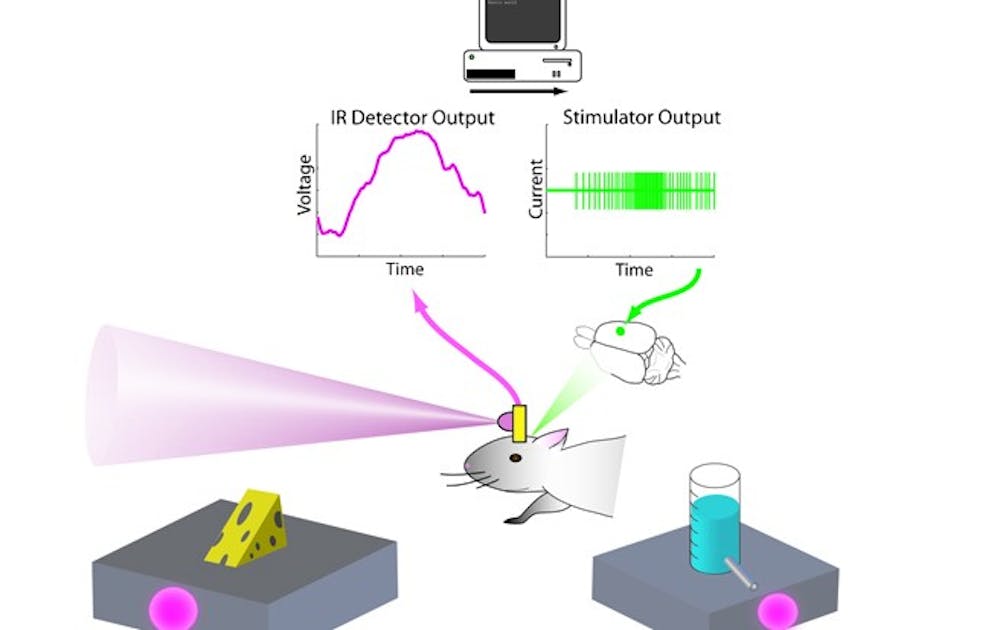Duke scientists studying brain implants engineered rats with a sixth sense that allows them to “feel” infrared light.
The team of neuroprosthetics researchers mounted an infrared camera on the head of a rat and connected it to the somatosensory cortex of the brain, which processes touch sensations from the rat’s whiskers. When the camera detected infrared light signals, the rat was able to determine the direction of the light not by sight but by touch, similar to a tickle or a deflection of the whiskers, and move towards it to get a reward.
This suggests that the rat perceived a wavelength of light that would normally be impossible to detect. The results, published last week in the journal Nature Communications, show that cross-modal perception—the superimposition of one sensory channel over another—is something that can be engineered, potentially for use in human prosthetics.
“It’s as if [the rats] have adopted novel foraging strategies to optimize the acquisition of this new type of information and it’s a type of information that this part of the brain isn’t used to,” said first author Eric Thomson, a postdoctoral researcher in the Nicolelis Lab, where the research was conducted.
The series of experiments that led to these conclusions required first that the rats be conditioned to detect and respond to normal light signals. The rats were placed in an area with three light sources and were taught to stick their nose into whichever one was shining in order to receive water. After the rats became proficient at this task, they were equipped with the infrared cameras, the light sources were changed to infrared light and the task was repeated.
“When the rats first received infrared stimulation, they responded by scratching their face and turning their heads left and right, as if someone were touching their face,” Thomson said.
But after training with the new gear and getting good at the task again, the rats started sweeping their heads back and forth to face the direction that gave the greatest signal strength. With no visual cues, the rats were able to orient themselves once again and walk towards the source of the infrared signal.
“The change in their behavior suggested that [the rats] had assimilated the information as a new modality,” said lab primary investigator Dr. Miguel Nicolelis, professor of neurobiology, biomedical engineering and psychology and neuroscience. “They were essentially feeling the infrared light... and could move towards it to collect a reward.”
This study takes advantage of the intricacies of sensory systems, all of which are “labeled lines,” according to Christina Williams, professor of psychology and neuroscience. There is a set neural pathway for a particular sense that can be stimulated in any fashion, natural or engineered. Therefore, any stimulus along the visual path will result in an image that can be “seen,” and any stimulus along the somatosensory path will be “felt,” even if the stimulus did not come from the eyes or skin, respectively.
There are instances, however, even in humans, in which cross-modal perception results in a mixing of senses.
“There is a phenomenon called synesthesia, which is kind of a violation of labeled lines,” Williams said. “There are a few very unique people who can [involuntarily] taste colors or experience ‘green’ when they see the letter ‘A.’”
This is essentially what Thomson and his colleagues have done. By taking what would normally be visual stimuli from infrared light and having it processed in the somatosensory cortex of the brain, these rats can now “feel” that wavelength of light. Furthermore, results did not seem to indicate any impairment of the somatosensory cortex’s ability to execute its original function, Nicolelis added.
Thomson’s study carries many implications in terms of modification for human prosthetics. Since it is now known that other parts of the brain are capable of processing visual information, people who are blind may benefit from cross-modal perception depending on the cause of their blindness as well.
“Some humans are blind because their visual cortex is damaged,” said Thomson. “In those cases, we’d want our neuroprosthetics to target another cortex… maybe the [somatosensory] cortex.”
Thomson’s use of infrared light has also prompted conversation about the possibility of future prosthetics that grant superhuman senses such as X-ray vision. Although he intends to continue his work using infrared, Thomson says that his choice of wavelength was indeed arbitrary and could have been any kind of electromagnetic wavelength, even X-ray.
Coupling X-ray images with stimulation of the visual cortex, using the procedure from the study, could theoretically produce the colloquial “X-ray vision,” Nicolelis added.
Get The Chronicle straight to your inbox
Signup for our weekly newsletter. Cancel at any time.

